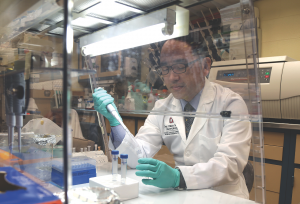
Virologist Chang-Won Lee conducts research — including the development of new vaccines and diagnostic tests — to combat avian flu and other respiratory diseases of poultry.
Since November 2014, an outbreak of highly pathogenic avian influenza H5 spread by wild waterfowl has gripped the U.S. poultry industry, killing close to 50 million birds in at least 19 states.
While the virus has not yet reached Ohio, Ohio Agricultural Research and Development Center experts are conducting innovative research to improve detection, prevention and management of avian flu and other respiratory diseases that threaten the state’s valuable poultry industry.
For instance, virologist Chang-Won Lee leads a U.S. Department of Agriculture $7.2 million grant that partners scientists and colleagues at The Ohio State University with other universities.
The project’s goal is threefold: to better understand the ecology of poultry diseases in order to develop more effective prevention strategies; to validate diagnostic methods currently employed and create better ones as needed; and to gain a better understanding of the relationship between disease, host and environment in order to aid in the development of new control methods.
ESSENTIALS
• The current avian flu outbreak is a serious threat to Ohio’s $2.3 billion poultry industry, which directly supports more than 14,600 jobs. Nationally, Ohio ranks second in egg production and ninth in turkey production.
• If Ohio were to experience just a 50 percent poultry production loss, Ohio State University Extension estimates the effect would reach $1 billion in overall economic losses, including $815,000 in annual wages.
• Heavy losses to Iowa’s egg farms from this virus have sent egg prices soaring across the United States. If the virus reaches Ohio, prices would increase even more dramatically, affecting both consumers and food manufacturers.
More: go.osu.edu/birdflu